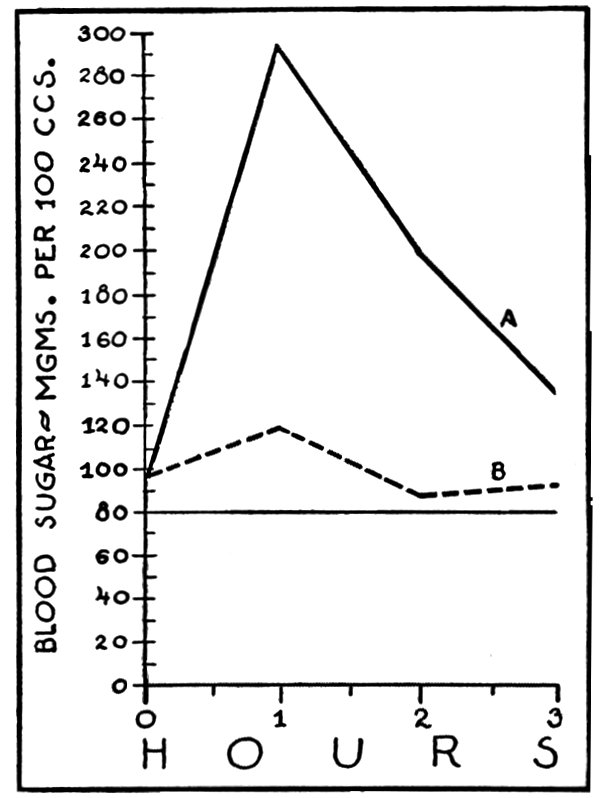
[back]
THE SIGNIFICANCE OF THE HYPERGLYCEMIC CURVE
There is a group of individuals who show high blood sugar with the glucose tolerance test. These individuals may have symptoms exactly like those found in individuals who show hypoglycemia with the glucose tolerance test and it is impossible to differentiate between the two except with the glucose tolerance test. Individuals with hyperglycemia are mild diabetic cases and sugar may be found in the urine after a meal containing sugar and starch, but not consistently, and the urine may be free of sugar after an all night fast. Fully developed cases of diabetes usually show urinary sugar consistently. Mild hyperglycemic patients are readily controlled by a low carbohydrate diet and usually have normal blood sugar levels on such a diet without the use of insulin, as shown in Fig. 7.
Mild hyperglycemia can cause symptoms similar to those found in hypoglycemic individuals and these symptoms are readily relieved by the same diet used in treating hypoglycemia, namely, a low-carbohydrate high-protein diet. Figs. 3, 5 and 6 readily show how the blood sugar is elevated to normal in hypoglycemic individuals; and Fig. 7 shows how the blood sugar is lowered to normal in hyperglycemic individuals. Severe hyperglycemic patients (frank diabetics) usually require insulin in addition to a diet. It is important to recognize mild hyperglycemic individuals because, if neglected, they may become frank diabetics.
The mild hyperglycemic individual has symptoms because of an inherent inability to utilize sugar and starch in the diet and because of the wide fluctuations in blood sugar levels. Fig. 7 shows how the blood sugar rises rapidly from a normal fasting level to an abnormally high level after one hour and then falls rapidly to around previous

FIG. 7
This figure shows the stabilizing effect of a low carbohydrate meal on the blood sugar in a hyperglycemic individual. Curve A was obtained after 100 grams of glucose; note sharp rise to abnormally high level followed by a rapid fall to previous fasting level which was within normal range. Symptoms exactly like those seen in hypoglycemia may occur during the period of rapid fall. Curve B was obtained after a low carbohydrate meal; note that blood sugar levels are within normal range and do not show wide fluctuations.
fasting level. Symptoms usually occur during the period of rapid fall. It has been found that symptoms depend not only on how low the blood sugar falls but also on the rate of fall in blood sugar level. Thus an individual with mild hyperglycemia may have symptoms while the blood sugar falls from 150 mg. to 100 mg. if the fall is rapid, despite the fact that the fall has occurred through normal range. This has been called "relative hypoglycemia." Symptoms of hyperglycemia are readily relieved by a low carbohydrate diet because the wide fluctuations are prevented and the blood sugar becomes stabilized.
Individuals with mild hyperglycemia, like untreated diabetics, are thus more susceptible to infection with polio because two factors are operating to produce susceptibility:
(1) the wide fluctuations in blood sugar levels with periods of rapid fall to relative hypoglycemic levels; and (2) the mild diabetic state which signifies an inherent inability to utilize sugar and starch in normal amounts. In individuals with hypoglycemia only one factor is operating to produce susceptibility, namely, the reduced utilization of sugar during the period of low blood sugar.